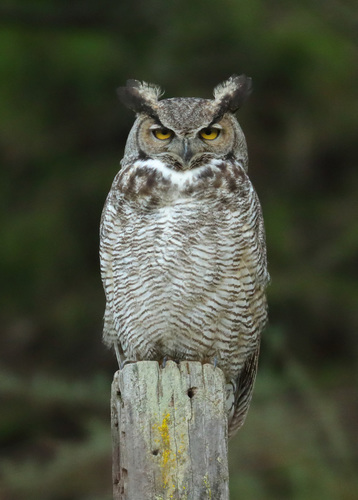
Great Horned Owl
The Great Horned Owl (Bubo virginianus) is a large, powerful owl native to the Americas. It is easily recognizable by its prominent ear tufts, often referred to as "horns," though they are not actually ears. This adaptable predator plays a crucial role in its ecosystem, controlling populations of rodents and other small animals. It's found in a wide variety of habitats, showcasing its remarkable resilience. The Great Horned Owl holds cultural significance in some Indigenous cultures, often symbolizing wisdom or protection, while in others, it can be seen as an omen.
43-64 cm
Length
91-153 cm
Wingspan
Least Concern
Conservation Status
Distribution
The Great Horned Owl has an extensive range, spanning from northern North America to parts of South America. It is absent from the high Arctic tundra and some Caribbean islands. It is generally non-migratory, although northern populations may move south in winter.
Lifespan
Up to 28 years in the wild; longer in captivity.
Great Horned Owl's Habitat
Habitat Types
Forests, Woodlands, Grasslands, Deserts, Wetlands, Urban areas, Suburban environments
Climate Zones
Arctic, Temperate, Subtropical, Tropical
Adaptations
Great Horned Owls are highly adaptable to diverse environments. Their broad diet and varied nesting sites allow them to thrive in a wide range of conditions. Their feathered legs and feet provide insulation in colder climates.
Variations
There are numerous recognized subspecies of Great Horned Owls, differing in coloration and size depending on geographic location. For example, Arctic populations tend to be paler, while those in more humid regions are darker.
Appearance
Breeding Plumage
Plumage is generally similar year-round.
Seasonal Feather Changes
Minimal seasonal variation.
Sex Based Plumage Differences
Limited sexual dimorphism in plumage; females may be slightly more reddish.
Notable Features
Prominent ear tufts (feather tufts, not ears), Large, forward-facing yellow eyes, Mottled brown, gray, and white plumage for camouflage, Feathered legs and feet
Diet and Feeding
Primary Foods
Mammals (rodents, rabbits, hares), Birds (including other raptors), Reptiles, Amphibians, Insects, Fish, Scorpions
Foraging Behavior
Primarily nocturnal hunters, Great Horned Owls use a 'sit-and-wait' strategy, perching and scanning for prey. They also fly low over the ground to ambush prey.
Specializations
Excellent night vision and hearing. Asymmetrical ear openings help pinpoint prey location. Sharp talons and powerful grip.
Seasonal Diet Variations
Diet varies depending on prey availability. In winter, they may rely more on larger prey items like rabbits.
Behavior
Social Structure
Generally solitary or in pairs, except during breeding season. Highly territorial.
Communication
Deep, resonant hooting (territorial and courtship), Screeches, hisses, and barks (alarm or defense), Bill-clapping (threat display)
Migration
Mostly non-migratory, but some northern populations may move south in winter in response to food scarcity.
Territorial or Group Behaviors
Highly territorial; defends territory through hooting and aggressive displays. Will attack intruders, including other Great Horned Owls.
Conservation
Threats
Habitat loss and fragmentation, Secondary poisoning (from rodenticides), Collisions with vehicles and power lines, Human persecution (though less common now)
Protection Programs
Migratory Bird Treaty Act (in the US), Various state and provincial wildlife regulations
Local National Laws
Protected under various national and international laws.
Population Trend
Stable
Population Estimates
Estimated global population of around 6 million.
Interesting Facts
They are sometimes called "tigers of the sky."
Due to their ferocity and hunting prowess.
Their eyes are fixed in their sockets.
They must turn their heads (up to 270 degrees) to look around.
They can prey on animals larger than themselves.
Including skunks, other raptors, and even domestic cats and small dogs.
Great Horned Owls have virtually silent flight.
Due to specialized feathers that reduce noise.
Faqs about Great Horned Owl
What do Great Horned Owls eat?
They have a very broad diet, including mammals, birds, reptiles, amphibians, insects, and even fish.
Where do Great Horned Owls live?
They are found in a wide variety of habitats across North and South America, from forests to deserts to urban areas.
Are Great Horned Owls dangerous to humans?
They are generally not aggressive towards humans unless threatened or protecting their nest. Attacks are very rare.
How long do Great Horned Owls live?
They can live up to 28 years in the wild, and even longer in captivity.
Do Great Horned Owls migrate?
Most Great Horned Owls are non-migratory, although some northern populations may move south during harsh winters.
Copyright @ Nature Style Limited. All Rights Reserved.
 English
English